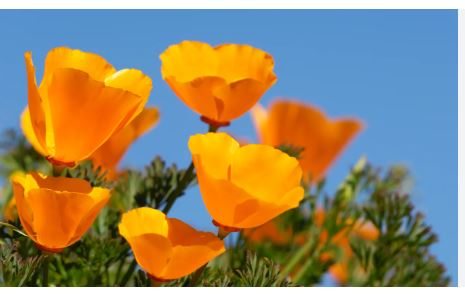
Eschscholzia californica, commonly known as the California Poppy, is a species within the Eschscholzia genus, which belongs to the Papaveraceae (poppy) family. This annual or short-lived perennial plant is distinguished by its bright orange flowers, though colors can range from yellow to red in cultivated varieties. The species name “californica” reflects its primary association with the state of California.
The California Poppy is native to the western United States, with its natural range predominantly in California, extending into Oregon, Washington, Nevada, Arizona, and parts of northwestern Mexico. It thrives in various habitats, including grasslands, deserts, coastal areas, and chaparral, showcasing its adaptability to well-drained, often sandy or rocky soils under full sun exposure.
Historically, Eschscholzia californica holds significant cultural importance in California. Named the official state flower in 1903, it symbolizes the Golden State’s sunny climate and rugged landscapes. Indigenous peoples used the plant for medicinal purposes, including as a sedative and for pain relief. The plant was first described botanically by Adelbert von Chamisso, a naturalist on the Russian ship Rurik during an expedition to California in the early 19th century, naming it after his colleague Johann Friedrich von Eschscholtz. Over time, the California Poppy has been popularized in gardening for its vibrant color, easy cultivation, and drought tolerance, leading to numerous cultivars and its use in landscaping and wildflower mixes.
California Poppy is suitable for USDA Hardiness Zones 6 through 10, although it can grow as an annual or biennial in cooler zones. It’s particularly well-adapted to the Mediterranean climate of its native region, where it can self-sow and naturalize, providing a burst of color in spring. Its preference for well-drained soils and its tolerance for heat and drought make it an excellent choice for xeriscaping, rock gardens, or any area where water conservation is key. However, in areas outside its native range, it might not perform as a perennial, acting instead as an annual or biennial due to climatic differences.
California Poppy (Eschscholzia californica): Characteristics
- Flower Appearance: Features bright orange, cup-shaped flowers that are often 2 to 3 inches wide, with four satiny petals. There are also varieties with yellow, pink, red, or white flowers.
- Bloom Time: Blooms profusely in spring, often from late winter through early summer, with some plants potentially blooming sporadically into autumn if conditions are favorable.
- Growth Habit: Grows as both an annual and a short-lived perennial, forming low, bushy clumps with heights typically ranging from 6 to 18 inches.
- Leaves: The foliage is finely dissected, giving leaves a lacy, fern-like appearance. They are bluish-green, adding a subtle contrast to the vibrant flowers.
- Root System: Has a taproot which allows it to thrive in poor, well-drained soils by reaching deep for moisture, contributing to its drought resistance.
- Adaptability: Highly adaptable to various soil types but prefers sandy, well-drained soils. It’s tolerant of poor soil fertility, making it ideal for low-maintenance gardens.
- Pollinator Attraction: Attracts bees, butterflies, and other pollinators, providing nectar while also supporting local biodiversity.
- Self-Seeding: One of its notable traits is its ability to self-sow, ensuring its return in subsequent years in favorable conditions, which helps in naturalizing landscapes.
- Sun Requirements: Requires full sun to bloom at its best; shade can lead to fewer flowers and less vigorous growth.
- Drought Tolerance: Once established, it’s extremely drought-tolerant, making it suitable for xeriscaping, wildflower meadows, or any garden where water conservation is a consideration.
California Poppy (Eschscholzia californica): Cultivation
- Site Selection: Choose a location with full sun exposure. California Poppies need at least 6 hours of direct sunlight daily for optimal blooming.
- Soil Preparation: Prefers well-drained, sandy, or gravelly soil. Amend heavy soils with sand or organic matter to enhance drainage. It’s tolerant of poor soil fertility.
- Planting: Sow seeds directly outdoors in fall or early spring for natural stratification. Plant seeds about 1/4 inch deep and 6 to 12 inches apart. Starting seeds indoors is less common due to their sensitivity to transplanting.
- Watering: Water seeds gently after planting to settle them into the soil. Once established, these plants are drought-tolerant, requiring minimal watering. Overwatering can lead to root rot.
- Mulching: Use a very light mulch, if any, to avoid covering seeds too deeply. Mulch can help retain moisture for germination but should not inhibit self-seeding.
- Fertilization: Fertilize sparingly or not at all; too much can lead to lush foliage with fewer flowers. If soil is extremely poor, a light application of a balanced, slow-release fertilizer might be beneficial.
- Pruning and Maintenance: Deadheading isn’t necessary as the flowers will naturally drop their petals, but removing spent flowers can tidy the garden and encourage more blooms. Cutting back after the first bloom can sometimes promote a second flowering.
- Pest and Disease Management: Generally pest and disease-resistant. Good drainage helps prevent fungal issues. Watch for aphids or caterpillars, which can be managed with minimal intervention or by encouraging natural predators.
- Propagation: Easily propagated by seeds, which can be collected from mature plants for future planting. The plant self-sows readily, ensuring its presence in the garden year after year.
- Winter Care: In its native range or similar climates, no winter care is needed as it self-sows. In colder zones where it’s grown as an annual, you might try to collect seeds for replanting the next season.